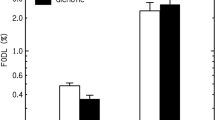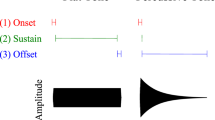Abstract
IT is well established that a sound consisting of adjacent harmonics is perceived as having the pitch of the fundamental frequency. This pitch is to be attributed to a component of subjective perception, that is, the combined impression of some or all of the tones presented. Such a component, which is not susceptible to further aural resolution, is called a residue1.
This is a preview of subscription content, access via your institution
Access options
Subscribe to this journal
Receive 51 print issues and online access
$199.00 per year
only $3.90 per issue
Buy this article
- Purchase on Springer Link
- Instant access to full article PDF
Prices may be subject to local taxes which are calculated during checkout
Similar content being viewed by others
References
Schouten, J. F., Proc. Acad. Sci. Amsterdam, 43, 356 (1940); Philips Tech. Rev., 5, 286 (1940).
Licklider, J. C. R., J. Acoust. Soc. Amer., 27, 996 (1955); Chap. 25 of S. S. Stevens's “Handbook of Experimental Psychology”, see p. 1019 (Wiley, New York).
Boer, E. de, “On the ‘Residue’ in Hearing”, thesis, Amsterdam (1956).
Author information
Authors and Affiliations
Rights and permissions
About this article
Cite this article
BOER, E. Pitch of Inharmonic Signals. Nature 178, 535–536 (1956). https://doi.org/10.1038/178535a0
Issue Date:
DOI: https://doi.org/10.1038/178535a0
This article is cited by
-
Assessing mechanisms of frequency discrimination by comparison of different measures over a wide frequency range
Scientific Reports (2023)
-
Exploiting individual differences to assess the role of place and phase locking cues in auditory frequency discrimination at 2 kHz
Scientific Reports (2023)
-
Mammalian cochlea as a physics guided evolution-optimized hearing sensor
Scientific Reports (2015)
-
Mammalian pitch sensation shaped by the cochlear fluid
Nature Physics (2014)
-
Pitch sensation involves stochastic resonance
Scientific Reports (2013)
Comments
By submitting a comment you agree to abide by our Terms and Community Guidelines. If you find something abusive or that does not comply with our terms or guidelines please flag it as inappropriate.



